Seventy Years Ago, Gretsch and Chet Inked a Most Important Deal
How Jimmie Webster made the historic 1954 endorsement deal possible.
By Ron Denny, Guest Contributor.
Seventy years ago, a contract was signed between a thirty-year-old ambitious musician named Chester B. “Chet” Atkins and Fred Gretsch, Jr., president of the Gretsch Company. As the ink was drying on the paper, neither man could have imagined how their fortunes were about to change.
And they had one man to thank for it: Jimmie Webster.
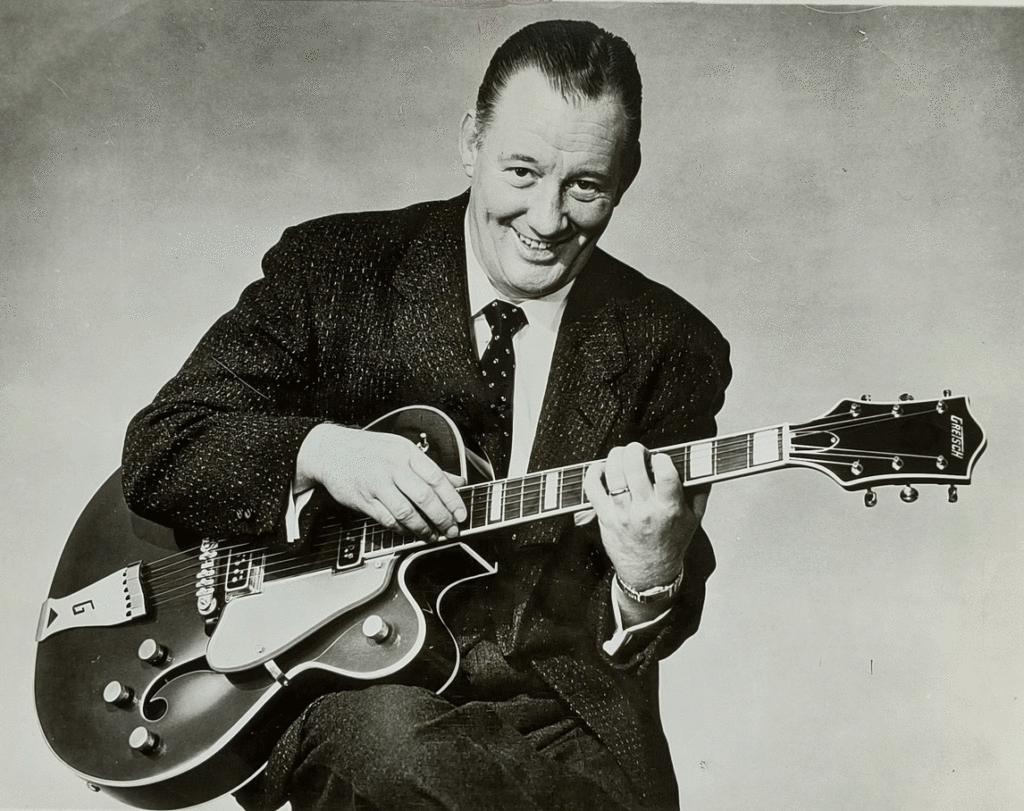
Jimmie Webster in 1955 demonstrating his Touch System method on a Cadillac Green Gretsch Country Club. Photo courtesy of Jim Hilmar.
Chet Atkins may have been earning the name of “Mr. Guitar” in the music world, but within the walls of the Gretsch Factory in Brooklyn, NY, Jimmie Webster was known as Gretsch’s “Mr. Guitar.” In the early 1950s, Webster, a popular and very talented guitar player—and some say an even better piano player—was given the task of leading Gretsch into the new, quickly-evolving world of electric guitars. Webster was seen as having the talent, knowledge, creativity, and persuasive personality to take Gretsch to another level, and be a serious contender to market leader Gibson.
In 1953, Webster launched his first salvo with the introduction of the “solid body” Gretsch Duo Jet electric guitar, an answer to Gibson’s new Les Paul model and Fender’s Telecaster. The Duo Jet was a hit and is still in production today, some seventy-plus years later. But Webster knew Gretsch needed a Les Paul of their own. He needed to sign a popular, hotshot guitarist who could be the new face of Gretsch guitars and whose name would grace a professional-level signature guitar.
As fate would have it, Chet and Jimmie’s paths would cross later that year. As the official ambassador of Gretsch guitars, Jimmie traveled around the country—and even parts of Europe—showing off Gretsch guitars and giving demonstrations and clinics at what was advertised as a Gretsch Guitarama. Webster was a talented guitarist, a charismatic performer, and known for his unique finger-tapping playing style (ala Eddie Van Halen) that he called the “Touch System.”
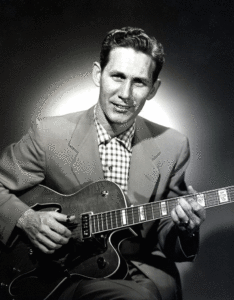
A 30-year-old Chet Atkins in 1954 with a prototype 6120 model guitar. Photo courtesy of Jim Hilmar.
According to Chet in his book, Chet Atkins: Me and My Guitars, Chet and some buddies happened to go to Jimmie’s Gretsch Guitarama show in Nashville and Chet was impressed with Jimmie’s playing skills. As fellow guitarists and “guitar nerds and tinkerers,” Jimmie and Chet hit it off and a friendship was formed. Timing is everything in show business, they say. And the timing couldn’t have been better for both a young, ambitious Chet Atkins—who’s star was rising rapidly and who was eager to get a guitar endorsement deal like his friend, Les Paul—and Gretsch, who was just as eager to hitch their wagon to the next guitar superstar.
It took a bit of persistence to win Mr. Guitar over (Chet wasn’t particularly fond of Gretsch’s current guitars and loved playing his self-modified D’Angelico Excel), but according to Chet, Jimmie was in Nashville on business and stopped by the Grand Ole Opry in the Ryman Auditorium to visit and chat. After being turned down again by Chet about becoming a Gretsch endorser, the persuasive Jimmie Webster said the magic words Chet was waiting to hear: “Would you say yes and become a Gretsch endorser if we let you design your own guitar?” Chet had a lot of ideas in his head on ways to improve the current state of electric guitars, so this was an offer he simply couldn’t refuse.
“I can see how my father cajoled Chet Atkins into going with Gretsch,” says Jennifer Webster Cohen, Jimmie’s daughter. “My father was friendly, outgoing, and very charming. And he also knew how to use those skills to persuade people. Plus, Dad was a very good guitar player, Chet even said so himself.”
Jimmie’s second biggest sales job came in convincing Fred Gretsch, Jr. that Chet was Gretsch’s man. The cities of Brooklyn and Nashville were polar opposites, and New York City wasn’t exactly a hot spot for country and western music. Jennifer continues by saying, “My father usually picked up Mr. Gretsch at his home in Manhasset and they’d ride in together to the Gretsch factory in Brooklyn. I’m sure Dad talked Mr. Gretsch’s ear off about Chet and why they needed to sign him. Like I said, my father had a real gift for persuading people.”
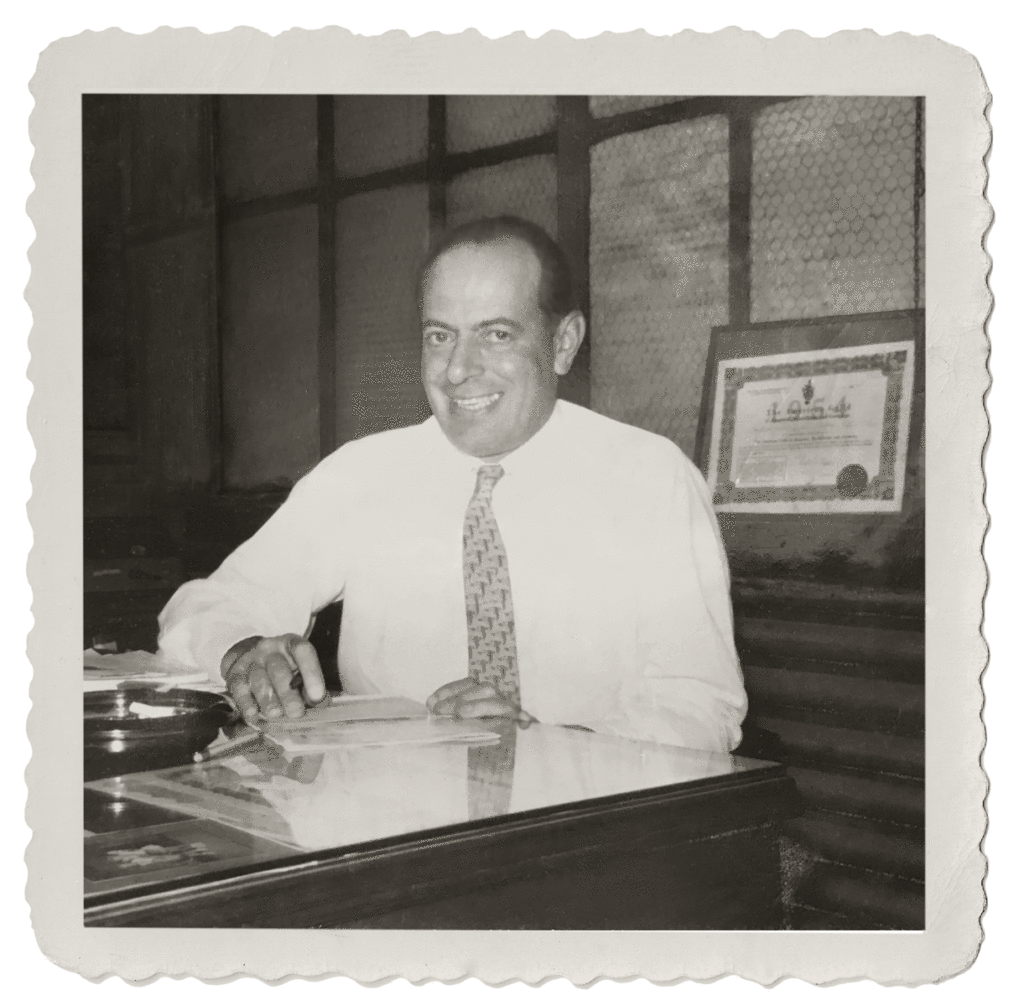
Fred Gretsch, Jr. at his desk in the Gretsch Factory in the mid-50s. It’s probably the desk where the Chet/Gretsch endorsement deal was signed.
It obviously worked because Chet was flown up to New York to meet with Fred, Jr. and they hit it off just fine and started hammering out the details of the endorsement. (Chet didn’t even bring a lawyer; he felt it would give a negative impression that he didn’t trust the Gretsch Company.) As promised, Chet worked with Jimmie and the Gretsch team in developing his signature hollow body guitar and was presented two prototypes with DeArmond single coil DynaSonic pickups and several western appointments recycled from Gretsch’s new cowboys-and-cactus themed Roundup guitar. The main changes Chet made were adding a metal bridge and a metal nut to improve sustain, and replacing the western-themed “campfire belt buckle tailpiece” with a fixed-arm Bigsby vibrato.
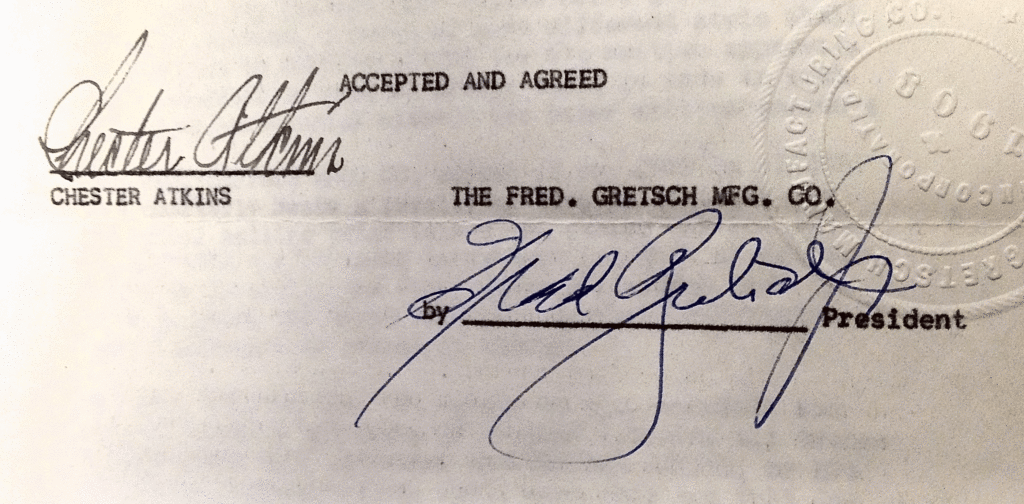
The signatures of Chester “Chet” Atkins and Fred Gretsch, Jr. on the endorsement contract dated July 6, 1954.
Although Chet wasn’t wild about the G Brand and other western and cowboy-themed appointments on his orange signature guitar, he was too anxious to get it into production to say no. And on January 1, 1955, the Chet Atkins Hollow Body Guitar, Model 6120, and a companion solid body Model 6121, started shipping to dealers.
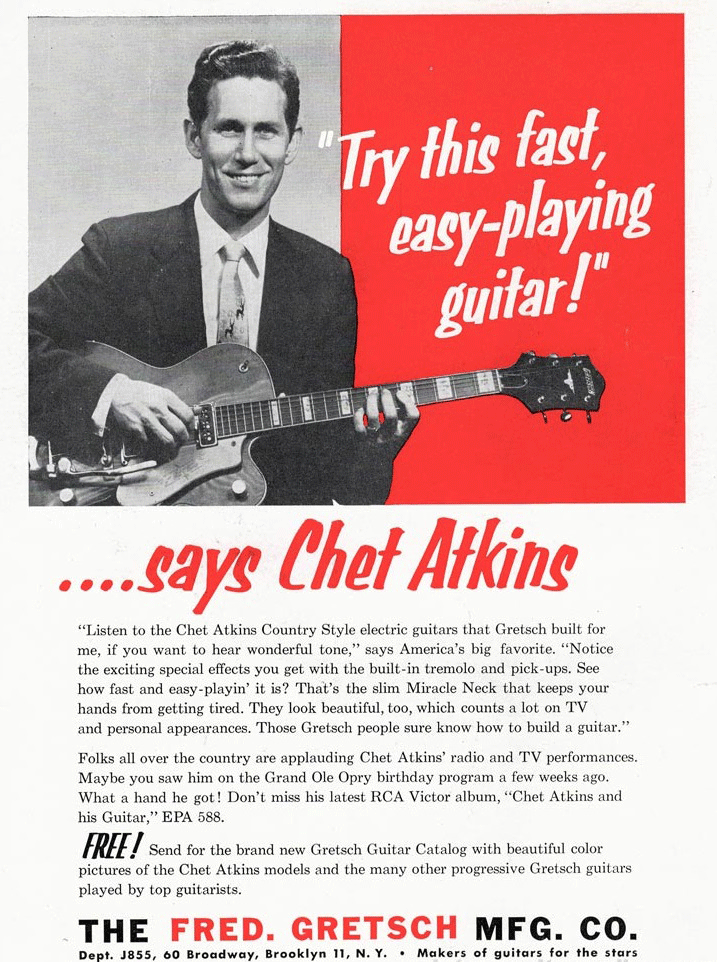
A 1955 print ad showing off Gretsch’s new star (Chet Atkins) and his signature guitar. Photo courtesy of Jim Hilmar.
Gretsch supported their new star with a full-blown print ad campaign featuring Chet holding his new Gretsch and enticing readers to “Try this fast, easy-playing guitar!” He and his signature guitars were also showcased in Gretsch’s first full-color 1955 catalog (that also introduced Jimmie Webster’s dream guitar: the opulent White Falcon).
The Chet Atkins 6120 was a sales success from day one and continues to be a big seller worldwide seventy-plus years later. The creative and innovative Jimmie Webster would continue to be Gretsch’s “Mr. Guitar” for the rest of the 50s and 60s. Many of the guitars he created during that golden era: the 6120, Country Gentleman, Tennessean, Anniversary, Duo Jet, Silver Jet, and, of course, the White Falcon and White Penguin, are considered classics and are still being produced in Gretsch factories today.
In reflecting back on his father’s success in being able to sign a major talent like Chet Atkins, Raey Webster, Jimmie’s son, says, “I believe what attracted Chet to Gretsch was that he wanted to have a role in improving the electric guitar—which was still in its infancy back in 1953 and 1954—and Gretsch was going to give him that opportunity. Plus, the innovations my father had already done—and wanted to do—with the electric guitar probably attracted Chet’s attention as well. In many ways, Chet and my father were on the same mission. And they certainly accomplished it.”
– – – – – – – – – – – – – – – – – – – –
Enjoy an extremely rare home movie of the July 1958 NAMM Show in Chicago showing Chet Atkins, Jimmie Webster, and Fred Gretsch, Jr.
_________________________________________________________________________________________________________________________________
Fred and Dinah are looking for your suggestions on how to expand the Jimmie Webster Memorial Scholarship at Berklee College of Music.
In August 2008, Fred and Dinah Gretsch paid tribute to the Gretsch Company’s “Mr. Guitar” on what would have been Jimmie Webster’s 100th birthday by establishing the Jimmie Webster Memorial Scholarship at the prestigious Berklee College of Music in Boston, Massachusetts. A special tribute to Jimmie was performed at the Berklee Performance Center on many of the electric guitars Jimmie created for Gretsch in the 1950s and 1960s. Ever an astute businessman, Jimmie would be proud that his name is on a scholarship that supports an outstanding student majoring in music business.
Jimmie Webster is also known for his leadership skills within the music industry and the communities in which he lived and did business in. Fred and Dinah would like to expand the current scholarship to include Musician Leadership Education. If you have best practice suggestions, please let the author of this article know by reaching out to Ron Denny at rondennymktg@gmail.com.



 Previous
Previous